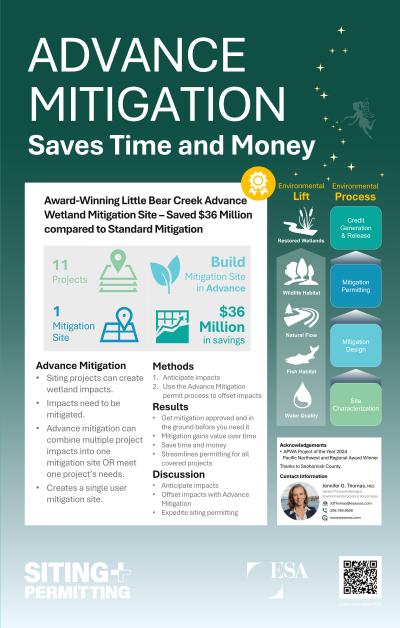Advance Mitigation Saves Time and Money
Tuesday, April 15, 2025
5:00 PM - 6:00 PM PT
Location: Regency Ballroom


Jennifer Thomas (she/her/hers)
Senior Principal Biologist
Environmental Science Associates
Seattle, Washington
Poster Presenter(s)
When it comes to permitting and compliance for projects across the country, there is a strong case for advanced mitigation tactics that meet applicable regulatory requirements. Compared to conventional concurrent mitigation, advance mitigation can save time and money and provide greater certainty for project proponents needing to compensate for wetland impacts associated with their projects. At the same time, the process for securing advance mitigation credits can be complex—potentially more complicated than conventional permittee-responsible mitigation and less prescriptive than banking or in-lieu fee mitigation. Case in point: ESA’s work at Little Bear Creek Advanced Mitigation Site in Snohomish County, Washington. Recognized as a 2024 Project of the Year by the American Public Works Association (APWA) Washington Chapter in the Environment Less than $5 Million category, this truly was a first-of-its-kind project. The advance mitigation site acquired by Snohomish County restored a formerly degraded area in Woodinville, Washington into 17 acres of protected forested wetland and salmonid-bearing stream habitat. ESA’s approach for the project enabled the County to earn advanced mitigation credits to meet regulatory requirements for 11 public works projects while saving the County over $35 million in the process. ESA led all phases of this project, including planning, design, permitting, and construction/implementation. The expertise and innovative programmatic approaches to mitigation and agency negotiation that we brought to this project were key to its success. This poster will provide an overview of what made this complicated project a success (did we mention we saved the client $35 million?), and what attendees at the ACP conference should be considering for advanced wetland mitigation for their energy development projects.
